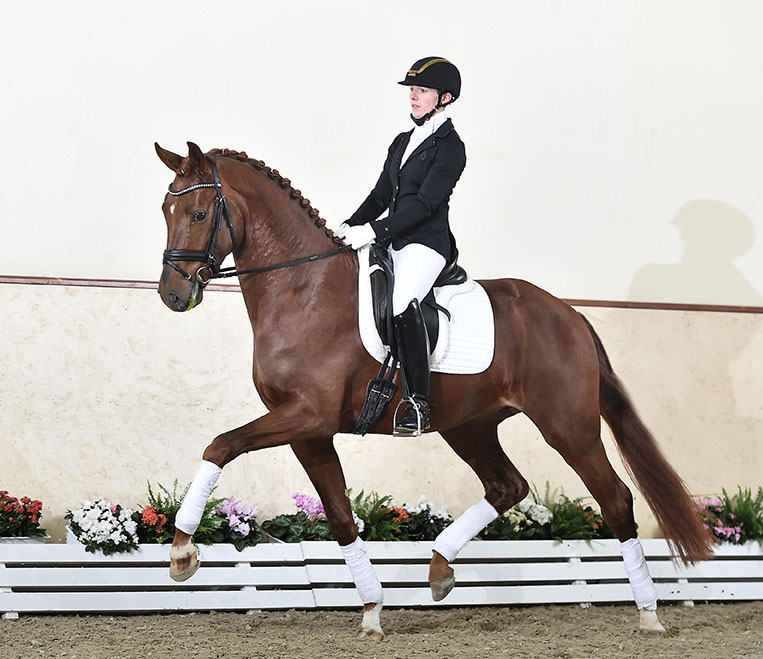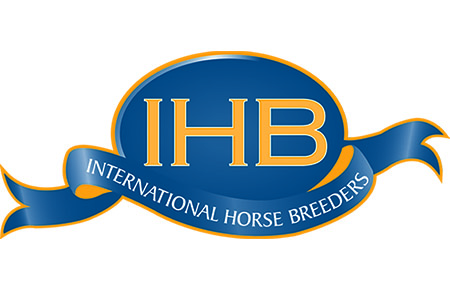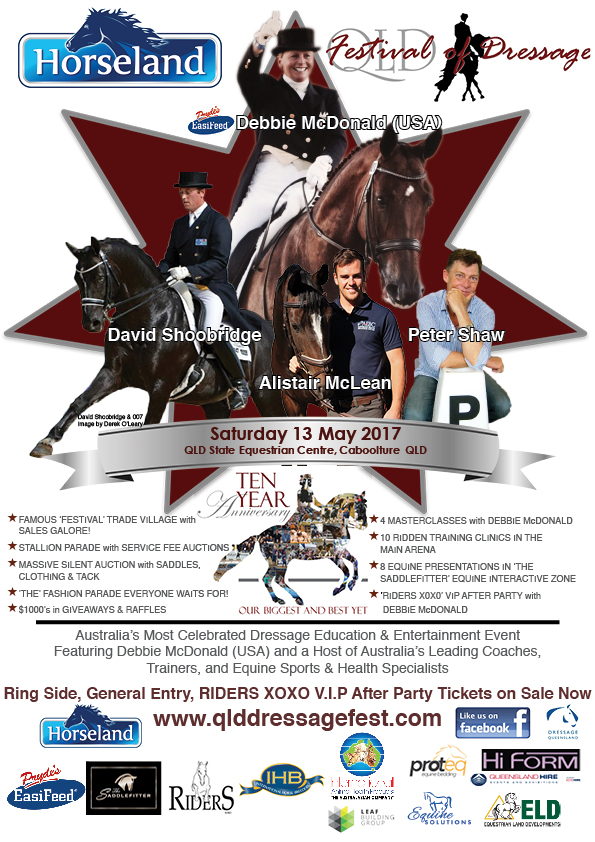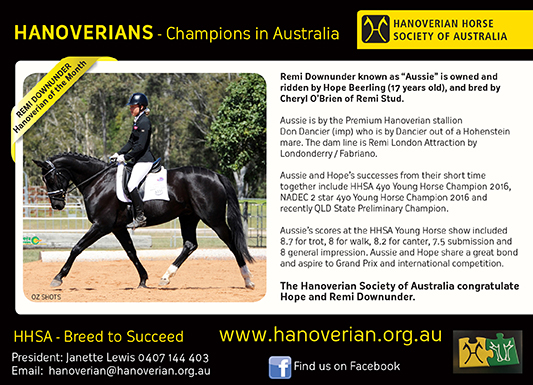 Rebecca Ashton profiles the newest star on the American dressage team – Allison Brock! Rebecca also took the photos…
Rebecca Ashton profiles the newest star on the American dressage team – Allison Brock! Rebecca also took the photos…
Allison Brock was a member of the bronze medal winning US Olympic dressage team at Rio. The 36-year-old upped and left home in Hawaii as a teenager and through sheer hard work, has reached the top of her sport. She might say she’s had a lot of luck, and people helping her along the way, but Allison is one of those perfect examples of you make your own luck. Her focus, determination and downright obsession means perhaps she couldn’t help but succeed. I caught up with Allison in Rio the day before the final.
Congratulations on the team bronze!
“Thank you. And I’m in the final, which is crazy. I wasn’t planning on it! I’ve never ridden my freestyle before. I’ve ridden parts of it but I haven’t ridden it through since we filmed it for the music. We’re going to be winging it. It’ll be fine, I’ll be able to have a bit of fun. This is just icing on the cake. I made it to the final of the Olympics, it’s all good. It’s a nice problem to have.”
Your first Grand Prix at an Olympics. What were you thinking when you came down that ramp into the arena?
“I was thinking, ‘Oh my god, I’m at the Olympics!’ I had that moment. I will tell you, when I started my canter tour, I started listening to the music and it was Anky’s old music from her Kür on Bonfire, Fading Like A Flower I heard it, lost count where I was at and thought, ‘Oh shit.’ I still kept riding my twos but I’m sure I missed the last two because I came off focus. That was my big mistake for the first day and I was mortified over it. I said, ‘I am not doing that for the Special’ and I didn’t. We were much better.”
Jeremy Steinberg told me you had an interesting story. You got here all on your own…
“I’m from Hawaii originally from non-horsey parents. I started riding when I was seven. I was horse mad and just begged and begged to ride. My parents are animal lovers but they have no idea where this horse thing came from. I have a little sister, but I was indulged. I was just horse crazy, I rode dressage, western and pony club.”
“Then when I turned 17, I finished high school, and just upped and left home. My parents were going through a pretty horrible divorce, and I kept being told you need to go to college, but I bought myself a ticket and just left to go and work in the States. I was a working student trying to scrape my way through. At 18, I moved to Texas and took a job with a Holsteiner breeding farm and worked for Jim Eldridge for a year and a half, mainly breaking horses. He also gave me a couple of FEI horses to ride every day which was amazing. We’re still quite close.”
“Then I got married… to an Australian…. which was a horrible mistake! I was just a baby. I was 19 and he needed a green card. He got it. We moved to Kansas City and I got hired by a lady named Linda Landers right off the bat. I walked in off the street and said I needed a job. That was unbelievably kind and generous of her. I met some incredible people including Jan Smith who owned a farm in Wellington, Florida and she let me take her horse to young riders when it was my last year to do it.”
It seems like everyone was giving you help at this stage, so you must have had something going on?
“When I think about it, I don’t think about myself like that, but I think people recognise those who are highly motivated, and hard working, and driven. I had so many fairy godmothers and people who stepped up to help me get to where I needed to go. Like Jan, who let me come and stay in her house. I was going to be in Wellington for one month, that’s all I could afford, and I had a horse with me on consignment from the people I had worked for in Texas. Jan let me live with her for free and I ended up staying two months. This was the winter of 2000-2001 and Sue Blinks was renting the arena where I was. I was working for Lauren Sanders who had a very active sales barn, and I was avoiding like hell riding in front of Sue at all costs, because she was one of the super stars for the US from the Sydney Olympics. I was terrified to ride in front of her. One day I just couldn’t avoid it, and I was riding the mare I brought with me, and she liked her. She asked if it was for sale and she wanted her working student to try her. The student tried her and didn’t like her, but Sue later tracked me down in the barn and said, ‘I want to try the horse, but I want to try her as many times as I feel, and I want you to show her, and want to haul her away to another arena to see how she is, I want to pre vet her.’ She had all these demands so I said, ‘That’s fine. I want a lesson.’”
“She did not buy the horse, but she did give me a lesson, and she did offer me a job. That was January 2001. I said to Sue I needed to go and do Young Riders with Jan Smith’s horse, because it was a big chance for me, but I would be in Wellington on November 1st to work for her. So I was her last unpaid working student.”
“Another fairy godmother of mine bought me a Saddlebred Hanoverian gelding that I had been riding. He was five-years-old and we didn’t pay a whole lot of money for him. I showed up in Florida with that horse to train with Sue Blinks. He was adorable, his name was Marky. I sold him when he was eight-and-a-half, and he was basically doing everything for the Grand Prix. Sue gave me a fantastic education. She really, really invested into me how to train.”
“Sue qualified for the 2002 WEG in Spain. I got divorced and went with her. We lived at Klaus Balkenhol’s and it was great. I met Debbie McDonald, Günter Seidl, Christine Traurig and Lisa Wilcox. I was 22 years old and had never been out of the country, and I was in the mix of it. Then we got a team silver at WEG. It was really incredible.”
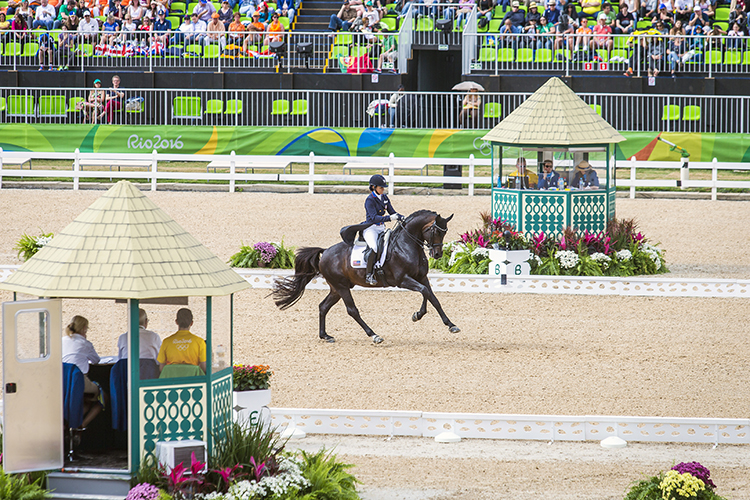
Tell me more about your first time in Germany. What was the biggest eye opener for you? The training?
“No, the training wasn’t dissimilar because of the people I had chosen to surround myself with. That was the nice part. More it was the culture of riding and training. The Germans take it so seriously, it’s a complete lifestyle, the breeding, everything, every angle on it. The seriousness of the horse shows was at a different level to anything I had been exposed to. And then to be behind the scenes with our top riders and to see them day in, and day out, and how they handle it and what it means to be on the backside of these huge events. People don’t realise what it takes to get these horses in the ring, healthy and happy. You see the ones that aren’t.”
“I continued working for Sue on our return and started freelancing to earn some income in 2003. We had a great arrangement. Sue’s sponsors, Fritz and Claudine Kundrun also helped me and in 2004, Sue moved to California and when she did, the Kundruns offered me her job. They just love dressage. Claudine is an avid rider and Fritz is an avid owner. (The Kundruns are major supporters of dressage in America. They owned Sue Blink’s Olympic mount Flim Flam and own the stallion Ampere. Last year the couple pledged USD$500,000 to dressage if matched by another one million by other contributors. Fritz told Dressage News last year, “….we are fortunate enough to be able to afford to be involved at the highest levels of the sport but many other people are not and we want to provide them the opportunity to do so.” No doubt Fritz recognises those who are willing to work hard to reach their goals….he ran the London Marathon at the age of 80 to bring awareness to the equine charity The Brooke)”
“Sue offered for me to go to California with her. It was a hard decision to make. I had just sold my Saddlebred/Hanoverian and I just decided I didn’t know if I’d have the opportunity again that I was offered. Fritz could buy young horses that were of such quality, and it was my opportunity to sit on that kind of horse flesh.”
“I’ve worked for them ever since. The first thing we did was to go out a buy a five-year-old Polish horse that we found called Peajay which I trained him up to Grand Prix.”
“Fritz bought Rosevelt in 2007 off a video. Sue had actually tried the horse in the Netherlands when Eugène Reesink owned him. He qualified with Hans Peter Minderhoud in the saddle to represent Germany in the World Young Horse Championships as a five-year-old.”
“I went to train with Jan Brink in 2008 and took Peajay, who was at that stage starting to do everything for the Grand Prix, and Rosevelt. I said, ‘Hey Jan, I’m bringing this stallion with me. I’ve never met him, but he is approved Swedish.’ He said , ‘Great I’ll put him on my breeding programme.’”
“I rode Rosevelt then did a demo with him at Flasterbo for Jan, he was six at that point but he had a hell of a time learning a flying change. I was in Sweden for about eight months and I ended up leaving him there when I went home, because we weren’t sure at that stage whether he was going to be an FEI horse.”
“Jan rang me up at the beginning of the horse’s seventh year and he said, ‘You know Alli, I think he’s going to be ok. I think he’s gong to be a good horse for you.’”
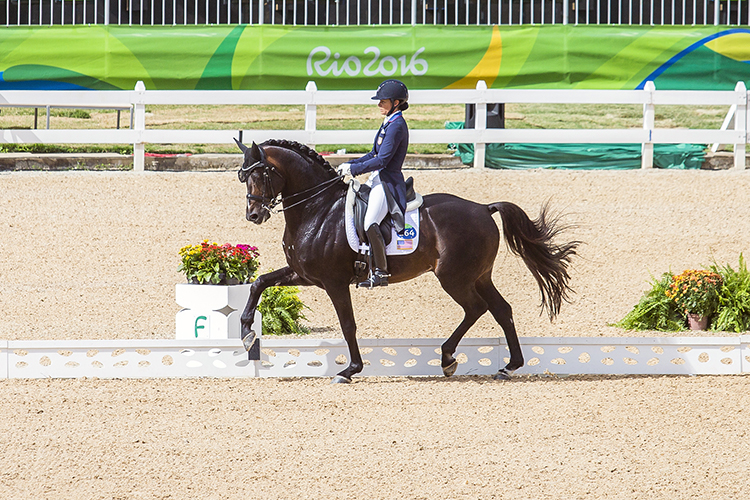
What was the change issue?
“Rosevelt had a very large canter stride. He has a short back but long legs and I think it just took him time to figure out how to use himself, because he’s a very honest sort of soul.”
“So I went back to Sweden in the fall of 2009 for three months, then landed back in Wellington with Rosevelt January 2010 and started showing him that month in small tour and developing horse classes. He did very well, we won five out of the six classes we entered up to a score of about 74%.”
“Then I stopped competing him because I knew I had to start working on the one tempis.”
“I had already approached Kyra Kyrklund to see if we could come and work with her and her husband the next year, and we had acquired at the end of 2010 a horse called Schumacher who had also done very well at the Young Horse Championships, and the Bundeschampionate, so my intention was to qualify him for the six year olds the next year and take him, Peajay and Rosevelt to Kyra’s.”
Why did you pick Kyra?
“Oh Kyra’s my idol! She’s still my idol. I just love how she rides and I had seen quite a bit of her at Jan’s because they bring her in every month to do clinics, so I was familiar with the style. Peajay got hurt so I had to leave him at home. Schumacher ended up winning the six-year-old International Championships at Hickstead that summer… in 2011.”
“I could already do four one time tempis on Rosevelt before we left so I said, ‘Don’t worry Fritz, I’ll be showing him Inter 2 by the fall.’ That horse didn’t do an Inter 2 until June of 2012. He had such a hard time learning the one tempis. The thing I have to say about Kyra and Richard, if you show up and say this is what I have to work with, they will figure a way to help you sort it out. Both of them busted their butts to help me get better as a rider trainer, and to get this horse educated. I think a lot of people would have said, ‘Alli, you’re wasting your time.’ They never said that.”
“As he became a Grand Prix horse, he got very hot and all of a sudden I had this horse that I could do this amazing trot tour on, and then in the canter he got too tight in the back. There was a lot of struggle with that, and he was quite explosive when I was showing him, I mean like really explosive.”
“We experimented and played with different ways to explain it to him. They let me fumble around with it for a very long time and then they finally said, ‘Alright, we need to divorce you from the situation.’ Kyra rode him for a couple of weeks and started to put in a new mechanism which really helped me and then it just took time for him to get comfortable with it.”
“I was in England for a year-and-a-half, and I eventually got Peajay over there but he got hurt again, so I couldn’t make a run at London with the horse. He was just not sound enough. I brought Schumacher and Rosevelt back to Wellington, but we had to end up retiring Schumy because he has a strange blood disorder – so he’s in a field now, which is a shame because he was probably the best horse I ever had.”
“So I was left with Rosevelt, and he’s like the little tough guy who just kept going and going.”
“So we started doing the Inter 2s and he was still really explosive, but the last Inter 2 he got 75% Then he started doing Grand Prix and getting 60% and then just kept notching it back up. In 2014 we did the big national dressage at Lexington. He won the Grand Prix on the first day with 73.5% and the second day a 77%.”
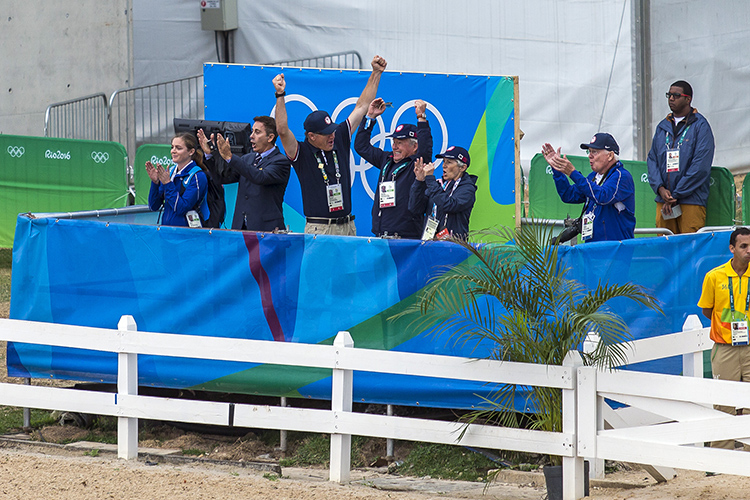
How did you get him calmer? Just match practice?
“Yes. I realised it didn’t matter what I did at home, he had to get used to the environment. I had to take my bumps in the back national rings, and just wait until he could cope with everything, and be rideable.”
How long did it take?
“He had a little bit of time off between 2013-2014, he got a bit footsore at the first CDI I took him to, but it took that horse a good year to calm. As I started doing the CDIs at Wellington, he had to do freestyles under the lights, which was very hard for him initially. But the more he went out, and did it, the better he got. The other thing too, I won’t run my horse more than once a month if possible. I don’t believe in it. Unless the horse has unlimited energy, I think you’ve got to be careful. I try to ride a real fine balance with that. This year in particular, I pulled him out for a month and just schooled him at home until I knew I could stop the one tempis. They went from being his most difficult thing to his favourite! He came back out and got 74, which guaranteed me my slot to go in the tour to go to Europe.”
What’s your daily routine at home?
“Normally at home, I rode Rosevelt first thing in the morning and he spends quite a bit of time in a snaffle. And he hacks out, he loves that, and he gets a lot of turn out. He’s not been able to do that since we’ve been over here, so that’s been a little bit rough. At home it’s much better divvied up between work and play. I think it’s been hard on them here… such a gruelling schedule. I’m constantly trying to keep my horse happy and positive, and feeling as good as he can.”
“Because I’ve been gone and been preparing for this, we shifted everything around quite a bit. I’ve also had a couple we have just retired, so I just have three at home. That’s a very small number. When I get back, we have a new mare coming then, I’m sure we’re going to look for some more young horses. I prefer to buy them four or five. It’s better to make them, you know everything about them. You don’t have to guess who did what to them when.”
Is Rosevelt breeding?
“He isn’t. It made his back too sore. When I’m done competing him, we’ll open him up to people. He’s 14 this year.”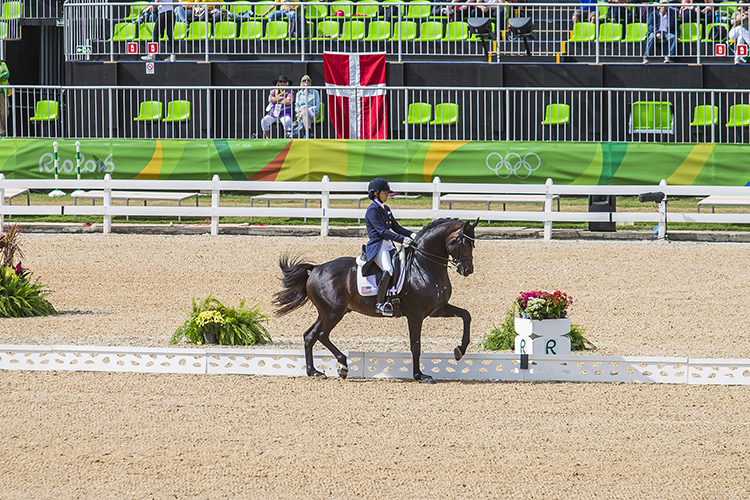
What’s he like as a person?
“He is lovely. He is a very sweet, sweet stallion, loves to be dirty, loves his turnout time, he loves to lay down and sunbathe. He sticks his tongue out and wants you to pat it, which is what my groom did the entire medal ceremony. She just sat there holding his tongue and he was as quiet as a church mouse. He’s a very friendly horse, to other horses and people. He also has this wicked playful streak that comes out in the jog, which is not funny. He really bounces around and can really be a strong idiot. But he doesn’t have a mean bone in his body. Honestly, that whole period when I was trying to get him acclimated into the ring and all that, he was just trying a little too hard and taking it a little too seriously in a way. He just needed time to realise that he could do it and relax. He’s lovely. Everybody loves him.”
Who do you train with now?
“After Sue left, I trained with Jane Savoie some. I still consider her a mentor and I really look up to her. Her attitude is amazing. She just attacks life. She’s fighting cancer right now. She’s fearless. That for me was really quite inspiring. She also articulates herself very well. She’s good at explaining. My trainer now is Michael Barisone.”
What do you do when you’re not riding or is there no such thing?
“You know, I’m a nerd. I read a lot, but really, I’m completely addicted to what I do so if I’m not riding myself, I’m out there teaching. I think that too is important, to learn to teach what you’re doing so it doesn’t get so automatic you can’t break it down for people.”
What’s the most important thing for you to teach your students?
“I think the most important thing is the attitude you bring into the ring. If you come in as a defensive student, you are going to have a very hard time getting better. You have to be willing to change. I think it’s like everything else. It’s very individual and some people have good position and feel, some people don’t. Some people need help with their timing, some people need really specific technical things with the exercises, and you have to be flexible as an instructor, but I can’t help you if you can’t hear me. I suggest that people be a good student, and that they be open to it, and work at it. If you do the same thing, you get the same. They have to be comfortable with being uncomfortable, and if you’re ok with that, you’ll grow a lot more and actually quicker.”
What do you feel has been the secret behind the success of the US Team?
“We are incredibly cohesive as a group; all the riders and trainers. No stone is left unturned. Whether that’s the training, the horses’ health, the travel. We’re meticulously focused on details. Robert (Dover, team chef) has done a very good job rallying and saying, ‘Alright everybody, I expect brilliance and greatness out of you and nothing less.’ You are not just turning up.”
“We’ve all been living together for the past three months, we all like each other. I really feel that I’ve gained three best friends. We’re a real team. We all train together, we watch each other ride when our trainers aren’t here. It’s a very friendly, open, supportive environment. It has been from the beginning. Laura, Casey and I have been showing together all winter, and we were even stabling together back then. Our barn name was, ‘All for one and one for all’. We’re tight.”
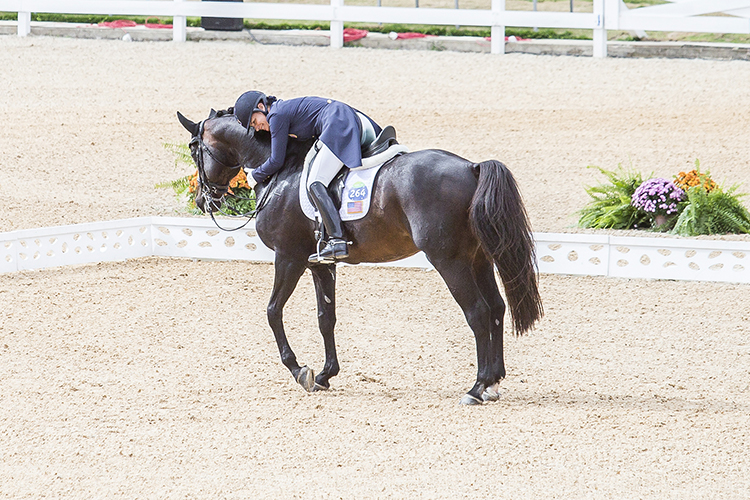 Would it work so well if you were scattered around Europe and America? Do you really need to all be together?
Would it work so well if you were scattered around Europe and America? Do you really need to all be together?
“Well, I think it works really well if you have the right people involved. I think if you had someone in there who was a troublemaker, it would be really difficult to spend that much time with them. What was cool about the Olympics here, everyone contributed to that medal. Everybody did what they needed to do.”
Has the whole experience changed you how you approach training etc?
“I think it’s always very good to watch good horses and good riders everyday, schooling and doing their thing, and I feel I learnt a lot watching my team mates school. And Debbie (McDonald) helped me a lot in July when Michael wasn’t there. And Steffen too. He has these incredible little tidbits that he’ll throw out there every once in a while and you think, ‘Oh, thanks for that!’”
“I think just going over to Europe and feeling the pressure of competing in the big shows is really important to come out of your comfort zone. It’s totally different. Global has quite a bit of atmosphere in its own right but nothing like, you know, Rotterdam was just a zoo! There’s a lot of atmosphere and pressure there.”
How do you cope with the pressure?
“I have a sports psychologist that I’ve worked with for years, and I actively work at making sure I’m mentally and emotionally in a good space. I’m not good with the physical stuff. I should. Casey exercises, Steffen works out everyday. Laura and I just look at them and go, ‘Have fun. We’ll have a glass of wine, thank you.’”
“One of things that helped me stay a little bit more sane on this trip, we just purchased a new coming five-year-old mare, so I had her with me in Belgium. It’s such a good reminder to be on young horses that it’s an incredibly long road and you really appreciate the fact that like Rosevelt at the moment, he has a PhD. He’s made it all the way to the top level, and it’s a long journey.”
What would be your advice to any young riders coming through the ranks?
“Work. Work your arse off. Go find whoever you admire the most, go beg them for a job. Then when you’re working, if you think you’re working hard, work harder.”
Offering the best dressage bloodlines in the world, F¨ürsten Jazz, right here in Australia.
Go to www.ihb.com.au for the complete range, including stallion that are new for the coming breeding season.
